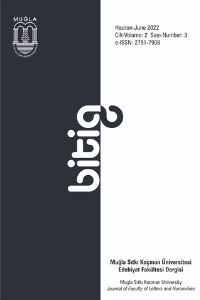Ahmed Paşa'nın Gazellerinin Dönüşüm Metaforu Bağlamında İncelenmesi
Klâsik Türk şiirinin âhenk unsurlarından olan metafor; ifadeyi ve sözü güzelleştirip, sözü, aşina olunanın dışına çıkartarak söylemektir. ”Meta (üzerine)” ve “phore (nakletmek)” olarak iki parçadan meydana gelen metafor, görünenin arkasını görmeyi ve arkasında görüneni ise görünenden farklı olarak aktarmayı sağlar. Aynı zamanda metafor, bir toplumun, kültürün birikimlerini içerisinde barındırır. Bu nedenle metaforu anlamak; insanın dünyasını, yetiştiği ve olgunlaştığı çevreyi, birikimlerini anlamaktan geçer. Metafor ve dil ilişkisine bakıldığında ise dil, soyut olanı somutlaştırmak ister. İşte bu sebeple metafora ihtiyaç duyar. Dil, zihinde soyut olarak var olanı metafor yardımıyla, somutlaştırır. G. ve L. Zaltman’ın, Metafor Çıkarım Tekniği’nde yer alan yedi derin metafordan seçtiğimiz dönüşüm metaforunda ise bu dünyanın, çevrenin ve birikimin izlerini takip edebiliriz. Dönüşüm, kimi zaman bedenimizde kimi zaman da ruhumuzda ortaya çıkar. Bu dönüşüm isteğimizle veya isteğimiz dışında olabileceği gibi, iyiye veya kötüye, olumluya veya olumsuza doğru da olabilir. Dönüşüm metaforu kademe kademe olgunlaşabilir ya da birdenbire ortaya çıkabilir. İnsanoğlu daha yaratılışında bir dönüşümün içine girer ve bu dönüşüm, hayatın son bulmasına kadar devam eder. Dönüşümün ve değişimin var olmaması, var olan dönüşümün ise durdurulması mümkün değildir. Dönüşüm yalnızca insanoğlunun etkilendiği bir olgu olmamakla beraber canlı, cansız birçok varlığı da etkisi altına almaktadır. Değişimin ellerinde geçen zaman; insanı, maddeyi, duyguyu, düşünceyi farklı olana dönüştürür. Bu çalışmada, Ahmed Paşa’nın gazellerinden seçilen örnek beyitler, dönüşüm metaforu bağlamında incelenecek ve örnekler üzerinden dönüşüm metaforu açıklanmaya devam edilecektir. Böylelikle klâsik Türk şiirinin kurucularından olan Ahmed Paşa’nın beyitlerinde dönüşüm metaforunun izleri aranıp, sahip olduğu metafor dünyası dikkatlerinize sunulacaktır.
The Analysis of Ahmed Pasha’s Gazelles in the Context of Transformation Metaphor
Metaphor, which is one of the harmonic elements of classical Turkish poetry; to say the word by beautifying the expression and the word and taking the word out of the familiar. The metaphor, which consists of two parts as meta (on)" and "phore", allows you to see the back of the view and transfer what appears behind it differently from the one that appears. At the same time, the metaphor contains the accumulations of a society, culture. Therefore, understanding the metaphor; to understand the world of man, the environment in which he grew up and matured, his accumulations. When looking at the relationship Between metaphor and language, language wants to embody the abstract. That's why he needs metaphors. Language embodies what exists in the mind abstractly with the help of metaphor. In G. and L. Zaltman's transformational metaphor, which we have selected from the seven deep metaphors in the Metaphor Inference Technique, we can follow in the footsteps of this world, the environment and the accumulation. Transformation occurs sometimes in our bodies and sometimes in our souls. This transformation can be with or against our will, or it can be for better or for worse, positive or negative. Human beings enter into a transformation in their creation, and this transformation continues until the end of life. The transformation metaphor can mature gradually or appear suddenly. It is not possible to stop the transformation and the transformation that exists. Transformation is not only a phenomenon that affects mankind, but also affects many living, inanimate beings. The time spent in the hands of change; it transforms man, matter, emotion, thought. In this study, sample verses selected from Ahmed Pasha's gazelles will be examined in the context of transformation metaphor and transformation metaphor will continue to be explained through the examples. Thus, the traces of transformation metaphor will be searched in the verses of Ahmed Pasha, one of the founders of classical Turkish poetry, and the world of metaphors will be presented to your attention.
___
- Tepebaşlı, Fatih (2013), Metafor Yazıları, Konya: Çizgi Yayınları.
